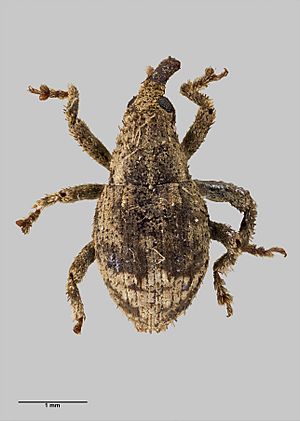Didymus metrosideri facts for kids
Quick facts for kids Didymus metrosideri |
|
|---|---|
 |
|
| Scientific classification | |
| Kingdom: | |
| Phylum: | |
| Class: | |
| Order: | |
| Superfamily: | |
| Family: | |
| Subfamily: |
Cryptorhynchinae
|
| Genus: | |
| Species: |
D. metrosideri
|
| Binomial name | |
| Didymus metrosideri (Broun, 1910)
|
|
| Synonyms | |
|
|
Didymus metrosideri is a special type of weevil (a kind of beetle) that lives only in one place. This means it is an endemic species. It comes from the Kermadec Islands, which are part of New Zealand.
This unique beetle was first found by a person named W. L. Wallace. He discovered it during a trip to the Kermadec Islands in 1908.
Contents
About Didymus metrosideri
Didymus metrosideri is a small insect. It belongs to a large group of insects called beetles. Weevils are known for their long snouts. These snouts help them to eat plants.
What is a Weevil?
Weevils are a type of beetle. They are part of the insect family called Curculionidae. There are many different kinds of weevils around the world. Most weevils eat plants. They can be found in many different habitats.
How We Classify This Beetle
Scientists use a system called Taxonomy to group living things. This helps them understand how different species are related.
Original Name and New Name
When Didymus metrosideri was first discovered, a scientist named Thomas Broun gave it a different name. He called it Acalles metrosiderae in 1910.
Later, in 1982, another scientist named G. Kuschel studied the beetle again. He suggested that it should be placed in a new group, or genus. So, the name was changed to Didymus metrosideri. This new genus, Didymus, replaced the old one, Acalles.
Where This Beetle Lives
This special weevil has only been found in a few places. Scientists have discovered specimens of Didymus metrosideri on two islands in the Kermadec group.
Islands Where It's Found
The main places where this beetle has been seen are:
These islands are small and remote. They are part of the Kermadec Islands chain. This makes Didymus metrosideri a truly unique part of New Zealand's wildlife.

